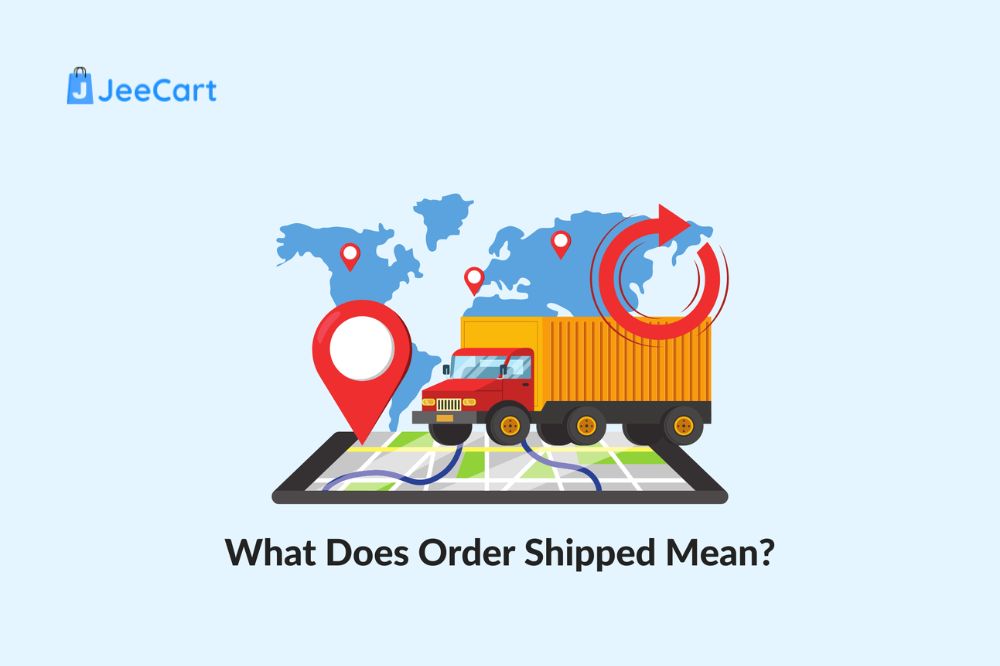
Online shopping has become more and more popular. That’s why understanding shipping terminology is crucial for both consumers and businesses. One common term that frequently appears in order tracking updates is “shipped.”
This term signifies a pivotal stage in the journey of a package from the seller to the buyer. Knowing what “order shipped” means, along with other related statuses, can help manage expectations and ensure a smoother shopping experience. This article explores the meaning of “order shipped,” differentiates it from other shipping statuses, and examines factors affecting shipping times.
What Does Order “Shipped” Mean?

When an order is marked as “shipped,” it means that the seller or the company has processed your order, packed it, and handed it over to the shipping carrier for delivery. Here are some key points about what “shipped” typically means:
- Order Processing Completed: The seller has completed the steps necessary to prepare your order for shipping. This includes picking the items from inventory, packing them securely, and creating the necessary shipping labels and documentation.
- Handed Over to Carrier: The package has been transferred to a shipping carrier (such as USPS, UPS, FedEx, DHL, etc.), which is now responsible for delivering it to the provided address.
- Tracking Information Available: Often, once an order is shipped, the seller will provide a tracking number which can be used to monitor the progress of the shipment and get an estimated delivery date.
- Transit Time Begins: The actual transit time from the moment the order is marked as shipped until it arrives at your address varies depending on the shipping method, the distance, and the efficiency of the shipping carrier.
- Responsibility Shift: Once the order is marked as shipped, responsibility for the package shifts to the shipping carrier. Any delays or issues during transit typically need to be addressed with the carrier, although the seller might assist in case of problems.
In summary, “shipped” indicates that your order is on its way and you should soon be able to track its progress and expect its arrival.
Other Common Tracking Statuses
![]()
There are 7 common tracking statuses you might encounter during the order-tracking process:
Accepted by Carrier:
- Meaning: The seller has prepared your order for shipping and handed it over to the shipping carrier, such as USPS, DHL, or FedEx. The carrier has acknowledged receipt of the package and will begin the delivery process.
- Details: This status signifies the start of the shipping process. It means the package is officially in the carrier’s system and will be processed for transit.
Arrived at the Regional Carrier Facility:
- Meaning: Your package has arrived at a major regional hub or fulfillment center.
- Details: This is typically the first stop in a network of sorting facilities. For example, if your package is traveling from Washington to Michigan, it might first arrive at a central hub in the Midwest. From there, it will be directed to more localized facilities.
Arrived at Local Carrier Facility or Post Office:
- Meaning: Your package has arrived at a local distribution center or post office closer to your delivery location.
- Details: This status indicates that the package is nearing its final destination. It is now in a facility that serves your local area and will soon be out for delivery.
In Transit:
- Meaning: The package is on its way to the destination.
- Details: During this stage, the package moves through the carrier’s network, traveling between various sorting facilities and transportation hubs. It indicates that the package is making progress towards delivery but is not yet at the final destination.
Out for Delivery:
- Meaning: The package has left the local delivery hub and is on its way to your delivery address.
- Details: This status typically appears on the day the package is scheduled to be delivered. It means the delivery driver has the package and will deliver it to your doorstep, often referred to as the last-mile delivery.
Attempted Delivery:
- Meaning: The delivery driver attempted to deliver the package but was not successful.
- Details: Common reasons for attempted delivery include the recipient not being home, an inaccessible delivery location, or needing a signature. The carrier will usually leave a notice and may make another delivery attempt, or the recipient may need to arrange for a re-delivery or pick up the package from a designated location.
Delivered:
- Meaning: The package has been successfully delivered to the specified address.
- Details: This status confirms that the package has reached its final destination and the delivery process is complete. Proof of delivery may be provided, such as a photo of the package at the doorstep or a signature confirmation.
Understanding these common shipping statuses helps you track your orders more effectively, providing insight into where your package is in the shipping process and what to expect next.
Which Factors Affecting Shipping Times?

Several factors can affect shipping times, influencing how quickly a package reaches its destination. Here are some of the key factors:
Shipping Method
- Standard vs. Express Shipping: Faster shipping options like express or overnight delivery will result in quicker shipping times compared to standard or economy shipping.
Carrier and Service
- Carrier Efficiency: Different carriers (USPS, FedEx, UPS, DHL, etc.) have varying levels of efficiency and service quality, which can impact delivery times.
- Service Level: Specific services offered by carriers (e.g., FedEx Ground vs. FedEx Express) have different transit times.
Distance and Location
- Distance from Origin to Destination: Longer distances generally result in longer shipping times.
- Remote Locations: Deliveries to remote or rural areas may take more time than deliveries to urban areas.
Weather and Natural Disasters
- Adverse Weather Conditions: Severe weather such as hurricanes, snowstorms, or floods can delay shipments.
- Natural Disasters: Events like earthquakes, wildfires, or other natural disasters can disrupt shipping routes and carrier operations.
Customs and International Shipping
- Customs Clearance: International shipments may be delayed at customs if there are issues with documentation, duties, or inspections.
- Import/Export Regulations: Different countries have varying regulations and procedures that can affect shipping times.
Holidays and Peak Seasons
- Holidays: National and local holidays can slow down shipping times as carriers may not operate or have reduced operations.
- Peak Seasons: High-demand periods such as Black Friday, Cyber Monday, and the holiday season can lead to delays due to increased shipment volumes.
Handling and Processing Times
- Seller Processing Time: The time it takes for the seller to process and prepare the order for shipment can affect overall shipping time.
- Carrier Processing Time: Delays can occur at the carrier’s sorting facilities due to high volumes or operational issues.
Customs and Border Inspections
- Customs Processing: International shipments can be delayed during customs inspections. This includes checking for restricted items, verifying documentation, and assessing duties and taxes.
- Quarantine Checks: Certain goods may require additional inspection, especially perishable or regulated items.
Supply Chain Disruptions
- Manufacturing Delays: Delays in the production of goods can lead to longer shipping times.
- Logistics Issues: Problems within the supply chain, such as port congestion or labor strikes, can also cause delays.
Pandemic or Health-Related Delays
- Health Measures: During health crises like the COVID-19 pandemic, additional health and safety measures can slow down shipping operations.
- Reduced Workforce: Carrier and logistics companies may operate with a reduced workforce, affecting their efficiency and speed.
Incorrect or Incomplete Information
- Address Issues: Incorrect or incomplete shipping addresses can lead to delays in delivery.
- Documentation Errors: Errors in shipping documents, such as invoices or packing slips, can cause delays especially in international shipping.
Understanding these factors can help you anticipate potential delays and better manage your expectations regarding shipping times.
Shipped vs Delivered: What are The Differences?
Shipped and Delivered are 2 statuses of the shipping process. Here is a clear, side-by-side comparison of the key differences between “Shipped” and “Delivered” statuses.
| Aspect | Shipped | Delivered |
| Meaning | The package has been processed, packed, and handed over to the shipping carrier. | The package has reached the recipient’s address and has been handed over successfully. |
| Process Stage | Early stage of the delivery process. | Final stage of the delivery process. |
| Location | In transit through the carrier’s network of facilities and transportation hubs. | At the recipient’s specified delivery address. |
| Carrier Handling | The carrier is responsible for moving the package through various transit points. | The carrier’s responsibility ends once delivery is confirmed. |
| Tracking Updates | Multiple updates, such as “In Transit,” “Arrived at Sorting Facility,” and “Out for Delivery.” | Final update indicating “Delivered,” with details like time and location. |
| Customer Action | No immediate action required; monitoring tracking is advisable. | Check delivery location and retrieve the package; contact carrier if there are issues. |
| Confirmation | Package is moving; no confirmation of receipt yet. | Delivery confirmation provided, may include a photo, signature, or delivery notice. |
What Does Order Shipped Mean: FAQs
What Does It Mean “Order Shipped”?
When an order is marked as “shipped,” it means that the seller has processed your order, packed it, and handed it over to the shipping carrier (such as USPS, FedEx, DHL, etc.) for delivery. At this point, the package is in the carrier’s possession and is on its way to the delivery address.
Does Shipped Mean Posted?
Yes, in most contexts, “shipped” and “posted” can be used interchangeably. Both terms indicate that the package has been dispatched and is in the process of being delivered. “Posted” is often used in regions such as the UK, while “shipped” is more common in the US.
What’s the Difference Between Shipped and Out for Delivery?
- Shipped: The package is in transit with the shipping carrier.
- Out for Delivery: The package is on the local delivery vehicle and will be delivered to you that day.
How Long After an Order is Shipped Does It Arrive?
Delivery time after an order is shipped depends on:
- Shipping Method: Standard (several days to weeks) vs. expedited (1-3 days).
- Carrier: Varies by service.
- Distance: Domestic (1-7 days) vs. international (1-4 weeks).
- Other Factors: Weather, holidays, customs, etc.
Conclusion
Understanding what “order shipped” means is essential for navigating the eCommerce landscape effectively. It marks the transition of your package from the seller to the shipping carrier, setting the stage for its journey to your doorstep. By differentiating between statuses like “shipped” and “out for delivery,” and considering factors that influence shipping times, consumers can better anticipate delivery schedules and confidently manage their orders. Armed with this knowledge, both buyers and sellers can enjoy a more seamless and informed online shopping experience.







